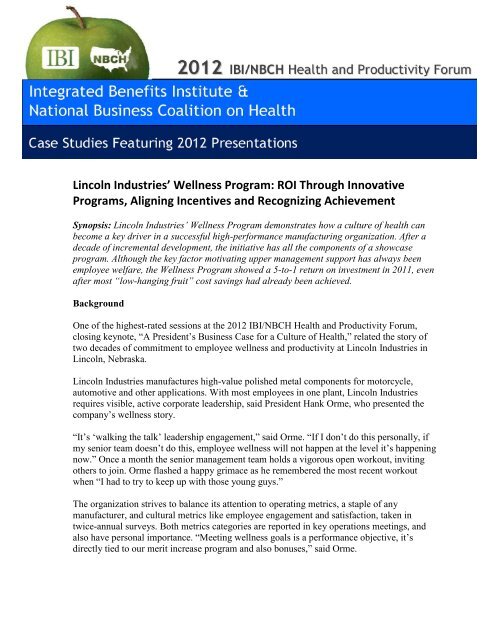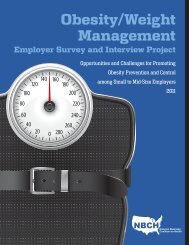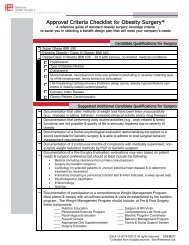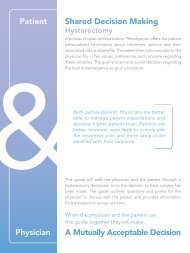Lincoln Industries' Wellness Program - National Business Coalition ...
Lincoln Industries' Wellness Program - National Business Coalition ...
Lincoln Industries' Wellness Program - National Business Coalition ...
You also want an ePaper? Increase the reach of your titles
YUMPU automatically turns print PDFs into web optimized ePapers that Google loves.
<strong>Lincoln</strong> Industries’ <strong>Wellness</strong> <strong>Program</strong>: ROI Through Innovative<br />
<strong>Program</strong>s, Aligning Incentives and Recognizing Achievement<br />
Synopsis: <strong>Lincoln</strong> Industries’ <strong>Wellness</strong> <strong>Program</strong> demonstrates how a culture of health can<br />
become a key driver in a successful high-performance manufacturing organization. After a<br />
decade of incremental development, the initiative has all the components of a showcase<br />
program. Although the key factor motivating upper management support has always been<br />
employee welfare, the <strong>Wellness</strong> <strong>Program</strong> showed a 5-to-1 return on investment in 2011, even<br />
after most “low-hanging fruit” cost savings had already been achieved.<br />
Background<br />
One of the highest-rated sessions at the 2012 IBI/NBCH Health and Productivity Forum,<br />
closing keynote, “A President’s <strong>Business</strong> Case for a Culture of Health,” related the story of<br />
two decades of commitment to employee wellness and productivity at <strong>Lincoln</strong> Industries in<br />
<strong>Lincoln</strong>, Nebraska.<br />
<strong>Lincoln</strong> Industries manufactures high-value polished metal components for motorcycle,<br />
automotive and other applications. With most employees in one plant, <strong>Lincoln</strong> Industries<br />
requires visible, active corporate leadership, said President Hank Orme, who presented the<br />
company’s wellness story.<br />
“It’s ‘walking the talk’ leadership engagement,” said Orme. “If I don’t do this personally, if<br />
my senior team doesn’t do this, employee wellness will not happen at the level it’s happening<br />
now.” Once a month the senior management team holds a vigorous open workout, inviting<br />
others to join. Orme flashed a happy grimace as he remembered the most recent workout<br />
when “I had to try to keep up with those young guys.”<br />
The organization strives to balance its attention to operating metrics, a staple of any<br />
manufacturer, and cultural metrics like employee engagement and satisfaction, taken in<br />
twice-annual surveys. Both metrics categories are reported in key operations meetings, and<br />
also have personal importance. “Meeting wellness goals is a performance objective, it’s<br />
directly tied to our merit increase program and also bonuses,” said Orme.
Every employee sets personal wellness objectives, and achieving them provides health plan<br />
premium discounts, contributions into their personal health reimbursement account, points<br />
toward the annual employee merit increase, and perks like contributions toward gym<br />
membership and home health equipment. Recognition in workforce meetings also is an<br />
important motivator.<br />
One of many measures of success in establishing a culture of health is that when Orme joined<br />
<strong>Lincoln</strong> Industries 13 years ago, 77% of employees used tobacco; today it’s 12% or fewer.<br />
Other measures:<br />
• Health care costs per person in their consumer-driven health plan (CDHP) were less<br />
than 59% of average costs for CDHPs in the region in 2011<br />
• 90% of employees have achieved incentives for reaching health goals, including nearly<br />
25% at the highest “Platinum” level.<br />
Diverse <strong>Program</strong>s<br />
The <strong>Wellness</strong> <strong>Program</strong> is an umbrella covering all programs related to employee health,<br />
wellness and productivity.<br />
Although the CDHP health plan has a silo of its own, it’s closely integrated with the<br />
<strong>Wellness</strong> <strong>Program</strong>, including the HealthyU onsite clinic providing free preventive care to all<br />
employees and family members 12 years old and above.<br />
Healthy U clinic, staffed by a physician assistant, is the venue to deliver many preventionoriented<br />
services. “We’re outcome-based on our incentives, metabolic syndrome risk factors<br />
and being tobacco-free, for example, we have premium discounts for those things through the<br />
health reimbursement arrangement,” explains Orme.<br />
The clinic is where many employees verify they’ve reached health measures. When<br />
employees make an appointment for a cold or other health need, they also get a SoundLife<br />
health coaching session to review personal health goals. Unlike the 15-minute sessions at<br />
most HMOs, employees get a half-hour at Healthy U.<br />
Physical exams are mandatory twice yearly, and include bloodwork for preventive health<br />
markers, chronic disease management and flu vaccinations. The company also holds<br />
quarterly health events with many of the same services, behavior change support coaching,<br />
and life planning with the employee’s “significant other” to further support personal progress<br />
toward health goals.<br />
Onsite fitness programs include free workouts with certified trainers in several workout<br />
formats, including P90X intensive workouts, kick-boxing, Jazzercise, Boot Camp and yoga.<br />
To be sure that everybody is ready for every work day, each shift begins with a stretching<br />
session for each crew.<br />
Rewards<br />
The <strong>Lincoln</strong> Industries <strong>Wellness</strong> <strong>Program</strong> has substantial rewards for high-performing<br />
participants.
In addition to financial incentives, it includes powerful intrinsic motivators. The points<br />
system has several levels, including Silver and Gold, and achieving Platinum status is like<br />
joining an elite club. Every year the Platinum achievers travel to a 14,000 foot mountain in<br />
Colorado and “summit” together in a group trip. “Last year more than 100 people qualified to<br />
summit together, this year we’re aiming for 125,” said Orme—nearly 25% of the <strong>Lincoln</strong><br />
Industries workforce.<br />
After the climb, the group enjoys a banquet with gifts. Participants tell personal stories about<br />
their journey to get there. Orme goes with the group as often as he can. Stories from people<br />
who summit with the group become part of the <strong>Lincoln</strong> Industries culture of health. Orme<br />
may mention participants in operations meetings, or look them up on the plant floor.<br />
He proudly told the stories of Seth and John, both athletes in high school who later fell into<br />
unhealthy lifestyles and became obese. The <strong>Wellness</strong> <strong>Program</strong> provided tools to re-take their<br />
lives. Seth ran his first marathon in 2010, and completed an ultra-marathon last year. The last<br />
time Orme talked with John, he was half-way to a bachelor’s degree with a 3.8 GPA. “It’s the<br />
stories that really matter to us,” said Orme.<br />
Calculating ROI<br />
<strong>Wellness</strong> efforts began more than 20 years ago with a general commitment to employee wellbeing<br />
and productivity. “Ten or 12 years ago we started seeing links between health care and<br />
workers’ compensation costs,” Orme said. “We tried to take even more advantage of our<br />
existing foundations.”<br />
A ramped-up <strong>Wellness</strong> <strong>Program</strong> effort produced an $11 to $1 return on investment (ROI) in<br />
2006. Even with most of the “low-hanging fruit” now plucked, <strong>Lincoln</strong> Industries estimated<br />
its <strong>Wellness</strong> ROI at $5 to $1 in 2011.<br />
“We’re very satisfied with that. I’d like to get that kind of return when we invest in<br />
machines,” said Orme.<br />
<strong>Lincoln</strong> Industries has many ways to capture savings generated by its <strong>Wellness</strong> <strong>Program</strong>.<br />
Components of Cost Savings, 2011<br />
Savings from Health Care Cost $1,701,459<br />
Savings from Workers’ Comp $(35,979)<br />
Savings from smoking cessation (6 months min.) $43,200<br />
Savings from intervention programs $315,000<br />
Savings from improved Absenteeism $315,958<br />
Savings from reduced Turnover $24,024<br />
TOTAL COST SAVINGS RELATED TO WELLNESS $2,363,662<br />
<strong>Wellness</strong> Related Costs $475,000<br />
Net Savings/Cost Avoidance $1,888,662<br />
The mature workers’ compensation (WC) program is operating with relatively flat costs. A<br />
slight increase in WC claim costs occurred in 2011 (see table above), but this occurred in the
context of a self-insured plan that has steadily reduced claim costs, reaching a low mod rate<br />
and requiring lower reserves than historically. Nearly 72% of the total savings are generated<br />
in health care cost—but other components also produce substantial savings:<br />
• Tobacco use in the employee population is down radically. Yet between new hires and the<br />
expectation that all smokers are encouraged to quit, nine employees successfully used the<br />
smoking cessation program in 2011, yielding a projected $4,800 in savings per participant.<br />
• Other intervention programs generate substantial cost reduction by changing health<br />
behavior, managing chronic diseases, and flu vaccination—very close in total savings to the<br />
absenteeism component.<br />
• Absenteeism savings are calculated in relation to the national average rate of 5%<br />
unplanned absence, estimated by the Society of Human Resource Management. <strong>Lincoln</strong><br />
Industries, with a rate of 3%, saves nearly $1,200 per employee at their average hourly cost<br />
of $19.93 in 2011.<br />
• Reduced turnover cost is calculated as 5% of total turnover cost for the year, on the<br />
assumption that wellness reduces turnover by 5%.<br />
The <strong>Wellness</strong> <strong>Program</strong> correlates wellness and productivity inside the organization, and<br />
compares its wellness culture to regional and national benchmarks. Measures of wellness and<br />
productivity include: participation in programs (reported at supervisor level), health<br />
outcomes as measured by prevalence of metabolic syndrome, and survey data from the Well-<br />
Being Assessment plus <strong>Lincoln</strong> Industries’ own internal opinion survey which measures<br />
culture components related to the company’s Beliefs and Drivers. <strong>Lincoln</strong> Industries’ average<br />
Gallup-Healthways Well-Being Index Composite Score is 74.1, higher than the community<br />
score of 72.8 for <strong>Lincoln</strong>, Nebraska.<br />
Conclusion<br />
The <strong>Lincoln</strong> Industries <strong>Wellness</strong> <strong>Program</strong> is driven by strong upper-management support for<br />
employee wellness and satisfaction, but also has produced an ROI that can justify wellness<br />
investments in other organizations. The virtues of incremental program development are on<br />
full display in the <strong>Lincoln</strong> Industries story, where a culture of health has become a key driver<br />
in a successful high-performance manufacturing organization.









